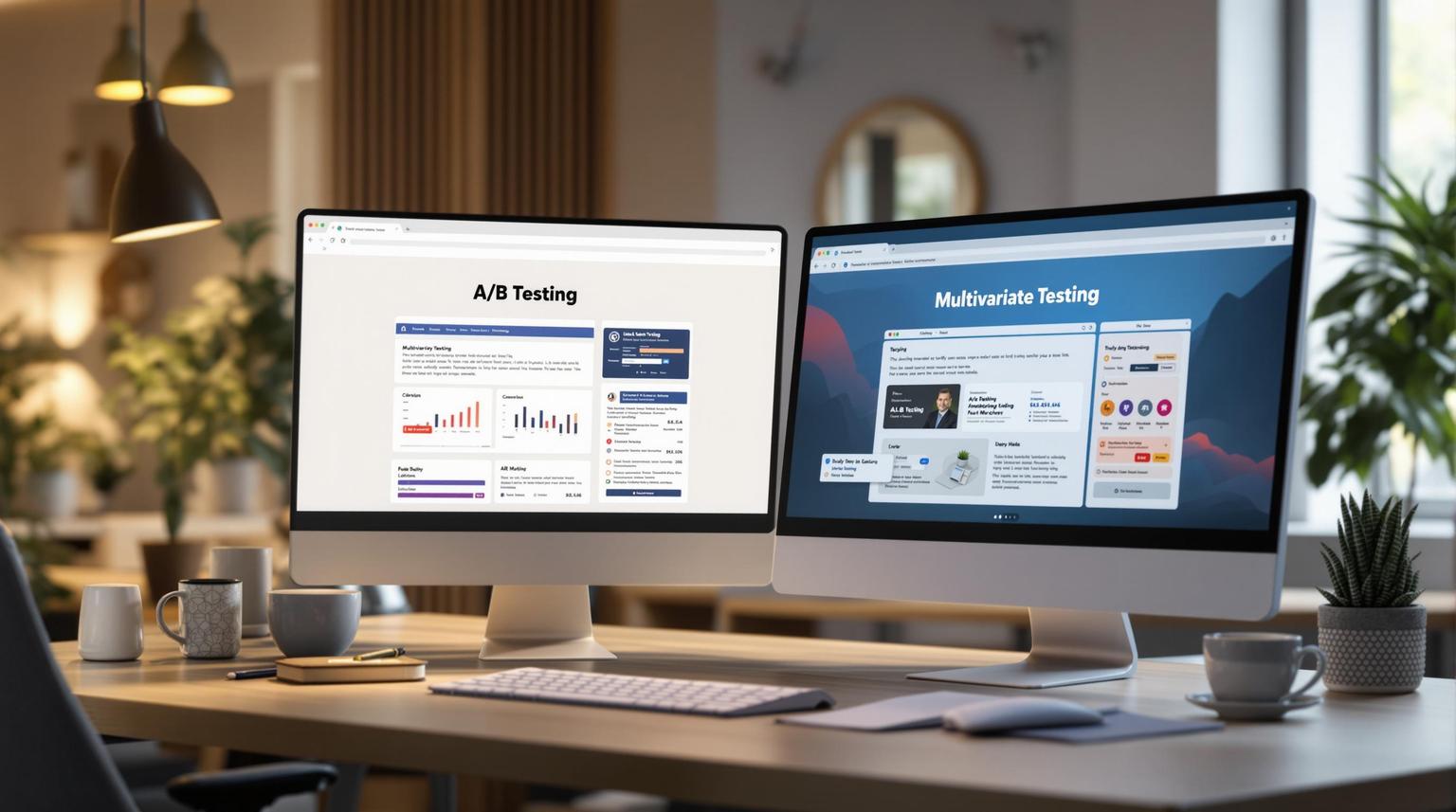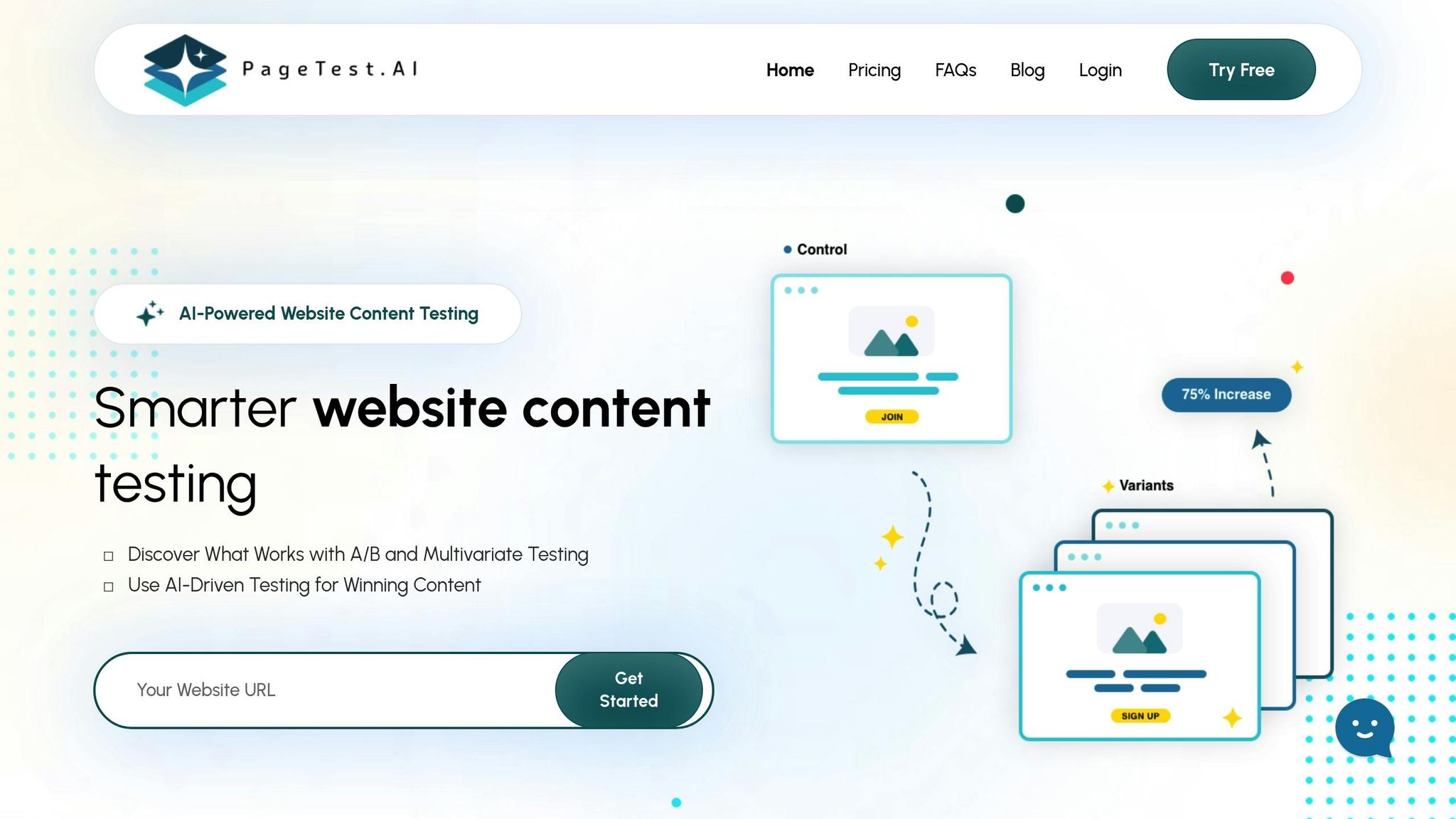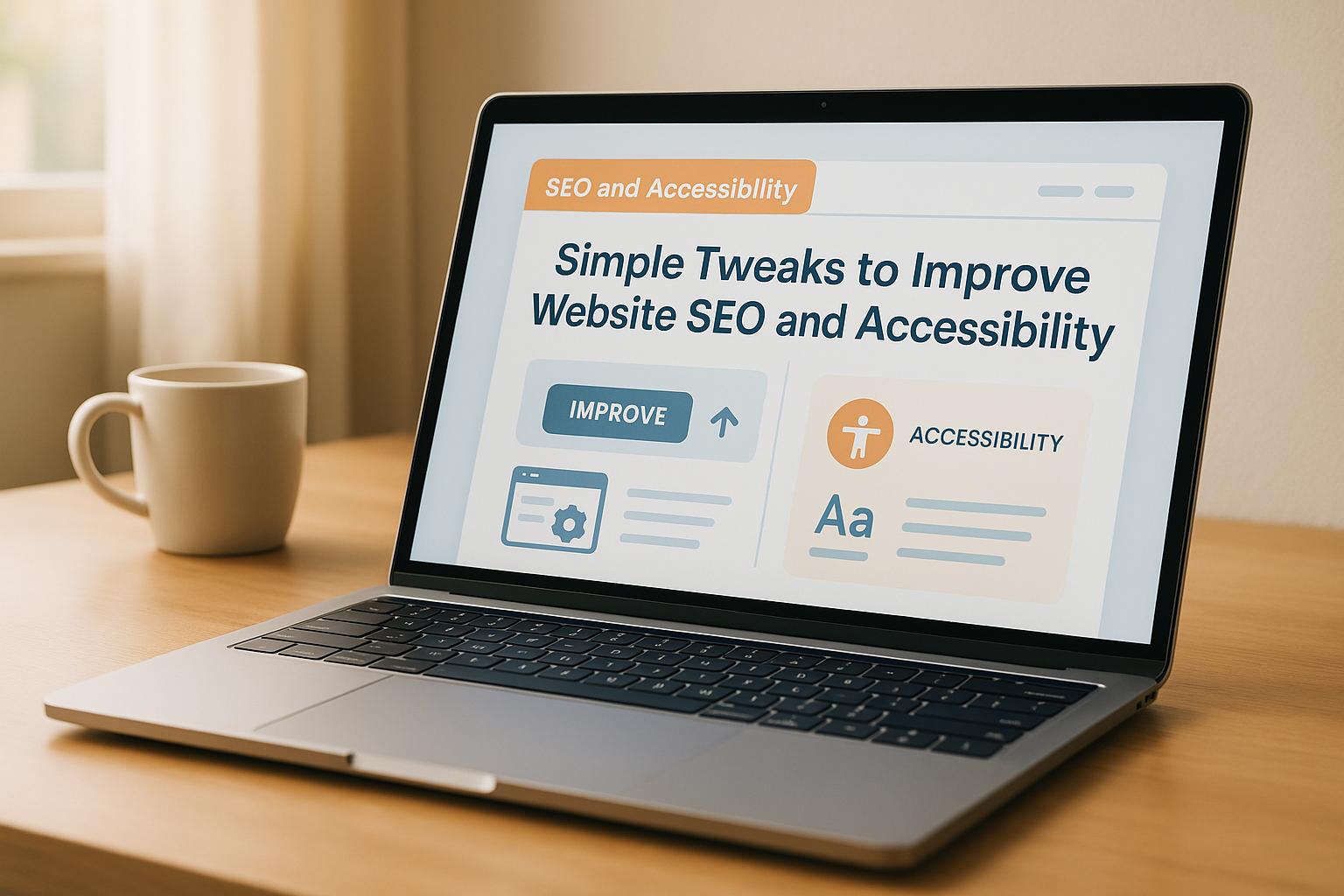

A/B Testing vs Multivariate Testing: Key Differences

A/B Testing vs Multivariate Testing: Key Differences
 18-06-2025 (Last modified: 18-06-2025)
18-06-2025 (Last modified: 18-06-2025)
Want to improve your website’s performance? Choosing between A/B testing and multivariate testing is crucial. Here’s a quick breakdown:
- A/B Testing: Compares two versions of a single element (e.g., button color or headline) to see which performs better. It’s simple, requires less traffic, and delivers faster results.
- Multivariate Testing: Tests multiple elements (e.g., headlines, images, layouts) and their combinations to find the best mix. It’s more complex, needs higher traffic, and provides deeper insights.
Quick Comparison
| Feature | A/B Testing | Multivariate Testing |
|---|---|---|
| Number of Variables | One | Multiple |
| Complexity | Simple | More Complex |
| Traffic Needs | Low | High |
| Time to Results | Faster | Slower |
| Insights | Focused on one change | Interaction of elements |
Bottom Line: Use A/B testing for quick, simple experiments. Opt for multivariate testing when you want to analyze how multiple elements work together. Both methods can help boost conversions and improve user experience.
When Should I Use A/B Testing Vs Multivariate Testing? – Marketing and Advertising Guru
What is A/B Testing?
A/B testing, also called split testing or bucket testing, is a method used to compare two versions of content to see which one performs better. It typically involves testing a control version (A) against a variant version (B) to determine which drives better results based on metrics like conversion rates, click-through rates, or engagement.
"The concept of A/B testing is simple: show different variations of your website to different people and measure which variation is the most effective at turning them into customers." – Dan Siroker and Pete Koomen
The beauty of A/B testing lies in its ability to shift decision-making from guesswork to data-driven insights. Instead of speculating on what your audience might prefer, you can test multiple options and rely on actual user behavior to guide your decisions.
How A/B Testing Works
The process of A/B testing is straightforward, making it accessible for businesses of all sizes. To begin, you create two versions of the element you want to test – this could be anything from website navigation and call-to-action buttons to design layouts or copy.
Traffic to your website is then split randomly between the two versions. Half of your visitors interact with version A (the control), while the other half sees version B (the variant). You measure which version performs better based on your specific goals, such as boosting sign-ups, increasing purchases, or improving engagement.
Statistical significance is key here. It ensures your results aren’t just due to random chance but reflect real patterns in user behavior. A bonus? A/B testing requires far less website traffic than more complex methods, making it an excellent choice for smaller businesses or websites just starting to optimize their user experience.
When to Use A/B Testing
A/B testing is especially useful when you have a clear hypothesis and need actionable insights quickly. It’s perfect for simple comparisons, like testing two font styles on a landing page or trying out different email subject lines.
This method is ideal for making incremental improvements by testing one change at a time. For example, if you’re debating whether a red or blue call-to-action button will get more clicks, A/B testing provides a definitive answer. It’s also effective when you’re working with limited traffic and need to focus on small, measurable changes.
Whether you’re comparing homepage layouts, experimenting with product descriptions, or evaluating pricing formats, A/B testing helps you pinpoint what works best – fast.
Benefits of A/B Testing
A/B testing offers plenty of advantages, making it a go-to tool for marketers and business owners. One major perk is that it’s easy to analyze since you’re only comparing two versions. This simplicity makes it easier to interpret results, even with limited traffic.
It’s also accessible to teams with fewer resources. A/B testing doesn’t require advanced technical support or expensive tools, making it a great option for small businesses or teams with tight budgets.
"It’s about being humble… maybe we don’t actually know what’s best, let’s look at data and use that to help guide us." – Dan Siroker
Another benefit is that A/B testing can be an ongoing process. Regular testing allows you to continuously refine your website or campaigns. With each test, you can set clear goals, measure results, and implement the winning variation to improve performance over time.
That said, A/B testing does have its limits. Since it focuses on one variable at a time, it offers clarity but doesn’t account for how multiple elements interact with each other. While this can be a limitation, it also ensures that your results are precise and actionable.
What is Multivariate Testing?
Multivariate testing (MVT) is a method used to improve websites by testing multiple variables at the same time to find the best-performing combination for driving conversions. Unlike A/B testing, which compares two versions of a single element, MVT digs deeper to examine how different elements interact to shape the overall user experience.
"Multivariate testing is a technique for testing a hypothesis in which multiple variables are modified. The goal of multivariate testing is to determine which combination of variations performs the best out of all of the possible combinations." – Optimizely
The core idea of multivariate testing is to run simultaneous tests on several elements to see how their combinations impact performance. For instance, a red button might work better with one headline, while a blue button may perform better with a different headline. This approach uncovers how elements work together – something A/B testing can’t do.
How Multivariate Testing Works
Multivariate testing involves a more intricate process but delivers deeper insights. First, you select multiple elements on your page – like headlines, images, call-to-action buttons, or layout arrangements – for testing. The testing software then creates all possible combinations of these elements and distributes your website traffic across them. By tracking performance metrics, it identifies the combination that achieves your goals, offering a detailed understanding of how these elements interact.
Take Hyundai.io as an example. They tested combinations of SEO-friendly text, additional call-to-action buttons, and different car image sizes (large versus thumbnail). After evaluating eight variations, they discovered that the version with SEO-friendly text, extra CTAs, and larger images led to a 62% increase in conversion rates for test drive requests and brochure downloads, while also boosting the click-through rate by 208%.
This method is particularly insightful for understanding which combinations of elements work best.
When to Use Multivariate Testing
Multivariate testing is especially useful for pages with multiple interactive components, such as e-commerce product pages, detailed landing pages, or dynamic homepages. It works best for websites with high traffic – ideally, at least 10,000 visitors per month – to ensure that each test variation collects enough data to produce reliable results. This approach is ideal for making incremental improvements to a design.
For example, if you’re optimizing a subscription form, you can test different layouts, messages, and designs all at once. It’s also helpful for determining how various types of content – like text, videos, or images – and their placement affect user engagement.
You might also use multivariate testing to refine email campaigns by testing different CTA button designs alongside varying marketing messages. Or, you could experiment with homepage layouts that include changes to banner placement, featured products, and navigation menus.
Pros and Cons of Multivariate Testing
Multivariate testing offers a detailed look at how different elements work together, making it a powerful tool for website optimization. Its main advantage is the ability to gather in-depth data about user preferences and behavior, which helps you fine-tune your site to better meet user needs. Testing multiple components at once also speeds up the optimization process for complex pages.
However, there are challenges. Multivariate testing requires a significant amount of website traffic to produce statistically reliable results. The setup and analysis can be complicated, often requiring advanced tools and technical expertise that smaller businesses might lack. Analyzing the interactions between multiple elements can also be tricky, and the outcomes are sometimes less predictable compared to simpler A/B tests. This added complexity increases the risk of unexpected results.
sbb-itb-6e49fcd
A/B Testing vs Multivariate Testing: Side-by-Side Comparison
Let’s break down A/B testing and multivariate testing to help you decide which approach suits your website optimization goals.
Comparison Chart: A/B Testing vs Multivariate Testing
Here’s a quick overview of how these two methods stack up:
| Aspect | A/B Testing | Multivariate Testing |
|---|---|---|
| Number of Variables | One | Multiple |
| Complexity | Simple | More Complex |
| Traffic Needs | Lower | Higher |
| Time to Results | Faster | Slower |
| Insights | Focused on individual changes | Explores interactions between elements |
| Sample Size | Smaller | Larger |
| Test Duration | Shorter | Longer |
| Best Use Case | Testing a single element | Optimizing multiple elements on a page |
A/B testing splits your audience into two groups, while multivariate testing divides visitors into multiple segments to test various combinations. Multivariate testing requires more traffic to deliver statistically reliable results, making it better suited for websites with high visitor numbers.
Now, let’s dive into specific scenarios where each method shines.
When A/B Testing is the Better Choice
A/B testing is a go-to option for those seeking quick, actionable insights without needing a massive audience. It’s particularly effective for testing significant changes like new page layouts, updated headlines, or redesigned call-to-action buttons.
This method works best when you’re comparing two distinct designs or elements and need results fast. It’s also great for beginners because it’s straightforward to set up and analyze. For example, if you’re deciding whether a red or blue button drives more clicks or if one headline outperforms another, A/B testing provides clear, definitive answers.
Startups and smaller businesses often prefer A/B testing due to its simplicity and lower resource demands. You don’t need advanced tools or deep technical expertise to get meaningful results.
When Multivariate Testing is the Better Choice
Multivariate testing, on the other hand, is ideal for more complex scenarios where you want to analyze how multiple page elements interact. This approach is perfect for websites with high traffic, as it requires a large sample size to produce reliable data within a reasonable timeframe.
If your page is already performing well but you’re looking to fine-tune it, multivariate testing can help you understand how combinations of text, images, call-to-action placements, and other elements impact user behavior. It’s particularly useful for optimizing intricate pages like e-commerce product listings, feature-rich homepages, or detailed landing pages.
Advanced users often favor multivariate testing because it provides deeper insights into how different elements work together. However, it does demand more advanced analysis skills and a thorough understanding of user behavior.
How to Pick the Right Testing Method
Choosing the best testing method depends on your website’s traffic, the resources you have available, and what you aim to achieve. Here’s a breakdown of the key factors to consider:
Factors to Consider When Choosing a Testing Method
Website Traffic Volume: The amount of traffic your site gets is a major factor. A/B testing works well for websites with lower traffic since it splits visitors between two versions of the page. On the other hand, multivariate testing, which involves testing multiple combinations of elements, requires significantly more traffic to produce reliable results.
Number of Elements to Test: If you’re testing one element (like a headline or button color), A/B testing is your go-to option. But if you want to test how multiple elements interact with each other, multivariate testing is the better choice.
Available Resources: A/B testing is simpler to set up and analyze, making it a good fit if you’re short on time or technical expertise. Multivariate testing, however, involves more complex analysis and requires more effort.
Your Testing Goals: Your objectives will also guide your decision. A/B testing is great for answering straightforward questions, such as “Which version of the call-to-action button gets more clicks?” Meanwhile, multivariate testing can uncover how different elements on a page work together.
Testing Timeline: If you’re working on a tight deadline, A/B testing is faster and can deliver results quickly. Multivariate testing, however, takes longer to reach statistical significance, making it better suited for longer-term projects.
It’s worth noting that only 1 in 8 A/B tests results in a meaningful change. That’s why it’s essential to approach testing strategically.
Now, let’s explore how PageTest.AI makes testing easier.
How PageTest.AI Makes Testing Easy

PageTest.AI takes the hassle out of both A/B and multivariate testing with its user-friendly, no-code platform. Compatible with WordPress, Shopify, Wix, and other website builders, it allows businesses to test effectively without needing technical expertise.
With its Chrome extension, you can effortlessly select any element on your site – like headlines, call-to-action buttons, or product descriptions – for testing. The point-and-click interface means you can set up tests in just minutes, no coding required.
For A/B testing, the platform’s AI-generated content variations are a game-changer. Instead of spending hours brainstorming new headlines or copy, PageTest.AI generates alternatives tailored to your content and industry standards, saving you time and effort.
Performance tracking is another standout feature. Beyond just tracking conversion rates, the platform monitors metrics like clicks, engagement time, scroll depth, and overall user behavior, giving you a detailed view of how changes impact your visitors.
When it comes to multivariate testing, PageTest.AI simplifies the process by managing the complex combinations and statistical calculations for you. All you need to do is choose the elements you want to test, and the platform handles the rest.
The pricing is flexible, catering to businesses of all sizes. From a free trial with 10,000 test impressions to enterprise-level plans, there’s an option for everyone.
Testing Tips for US Businesses
For businesses targeting American audiences, localization is key. Use familiar formats, such as displaying prices with dollar signs (e.g., $1,299.99) and following the MM/DD/YYYY date format (e.g., 12/25/2024).
Timing also plays a role. Be cautious about running major tests during periods like Thanksgiving, the Christmas-New Year holiday stretch, or events like the Super Bowl, as user behavior can vary significantly during these times.
With a large share of US web traffic coming from mobile devices, prioritize mobile-first testing. Ensure that all test variations are optimized for smartphones and tablets, as well as desktops.
Regional differences can also influence results. A headline that resonates in one part of the country might not perform as well in another. If your site gets enough traffic, consider segmenting tests by region to account for these variations.
Start with A/B testing to validate individual changes. As your traffic grows, you can move on to multivariate testing to fine-tune your strategy. Once you find statistically significant results, make those changes your new standard and keep testing to improve further. Always base your experiments on clear hypotheses informed by user feedback, analytics, or conversion principles to boost your chances of success.
Conclusion: Choose Your Testing Strategy
Optimizing your website doesn’t have to be overly complicated. Picking the right testing method – A/B testing or multivariate testing – can make all the difference in improving your site’s performance. Knowing when and how to use each approach will help you make smarter decisions for your digital marketing strategy.
Key Takeaways
A/B testing is a great starting point for most optimization efforts. It’s simple, requires less traffic, and provides clear results when testing individual elements like headlines, button colors, or call-to-action text. Since it compares two versions of a specific element to see which performs better, it’s ideal for businesses with limited traffic or those new to conversion optimization.
Multivariate testing works best for websites with high daily traffic and when you want to see how various elements interact. This method tests multiple page elements at the same time to find the most effective combination, making it a solid choice for more in-depth page redesigns. However, it demands more time and effort than A/B testing, which is known for its simplicity and straightforward results.
Armed with these insights, you can confidently plan your testing strategy to improve your website’s performance.
Practical Steps to Get Started
- Begin with A/B testing. Focus on impactful elements like headlines, product descriptions, or pricing. Make sure to craft a SMART hypothesis (specific, measurable, actionable, relevant, and testable) before running your tests.
- Simplify your process with PageTest.AI. This tool’s Chrome extension allows you to highlight elements on your site for testing, while its AI generates optimized content alternatives for both A/B and multivariate tests.
- Plan each test with a clear objective. Prioritize elements that are likely to have the greatest impact on your conversion rates. Once you identify a winning version, implement it and move on to testing other elements.
- Scale your efforts gradually. As your site traffic increases and you become more comfortable with A/B testing, you can transition to multivariate testing for more complex projects. Keep in mind that multivariate testing is best suited for sites with significant daily traffic.
FAQs
How can I decide whether A/B testing or multivariate testing is better for my website’s traffic and goals?
When deciding between A/B testing and multivariate testing, it all comes down to your website’s traffic and your testing goals.
For websites with low to moderate traffic or when you’re focusing on a single change – like testing a new headline or button color – A/B testing is the way to go. It’s straightforward: compare two versions of one element to see which performs better.
On the other hand, if your website attracts high traffic and has a more intricate design, multivariate testing is better suited. This method lets you test multiple elements – such as headlines, images, and buttons – simultaneously, helping you understand how these elements work together. Keep in mind, though, multivariate testing needs a large volume of traffic to deliver accurate insights.
In short, A/B testing works best for simpler tweaks, while multivariate testing is ideal for analyzing how various elements interact on a busy site.
How can I ensure accurate and statistically significant results in A/B and multivariate testing?
To get reliable results from A/B and multivariate testing, start by making sure you have a large enough sample size. This depends on your website traffic and the confidence level you’re aiming for – usually 90-95%. Next, define specific success metrics that match your goals, like conversion rates or click-through rates. And don’t rush – your test needs to run long enough to capture natural variations in user behavior over time.
Keep an eye on your traffic levels to avoid skewed outcomes, which can lead to misleading conclusions. For A/B tests, focus on testing just one variable at a time to clearly see its impact. With multivariate testing, ensure you’ve outlined all variable combinations so you can pinpoint how different factors interact. Following these steps allows you to make smarter, data-backed decisions and fine-tune your website for better results.
Can I combine A/B testing and multivariate testing, and how should I decide what to test first?
Yes, you can use A/B testing and multivariate testing together, but it’s important to know how they differ and when to use each. A/B testing focuses on comparing two or more entirely different versions of a webpage to determine which one performs better. Meanwhile, multivariate testing evaluates multiple elements on a page at the same time to understand how their combinations influence results.
A good strategy is to begin with A/B testing to identify the most impactful single change – like tweaking a headline or adjusting a call-to-action. Once you’ve nailed down those key improvements, switch to multivariate testing to refine the combinations of various elements and optimize the page’s overall performance. This step-by-step approach keeps things manageable while delivering meaningful insights.
Related posts
say hello to easy Content Testing
try PageTest.AI tool for free
Start making the most of your websites traffic and optimize your content and CTAs.
Related Posts

 11-09-2025
11-09-2025
 Becky Halls
Becky Halls
Expert Insight: Apple AI’s World Knowledge Answers
If you’re like us and have come across the terms ‘World Knowledge Answers’ and ‘Apple’s AI Search Engine’ and wondered what it’s all about then fear not – we did some research and thought we’d share what we’re gathered so far. We will regularly update our knowledge, as and when further information becomes available, so […]

 08-09-2025
08-09-2025
 Ian Naylor
Ian Naylor
Practical CRO Strategies for Publishers and Retailers
Discover 2025’s best CRO strategies for publishers and retailers, including experimentation culture, AI-driven optimization, and reader engagement insights.

 08-09-2025
08-09-2025
 Ian Naylor
Ian Naylor
Simple Tweaks to Improve Website SEO and Accessibility
Discover 10 simple tweaks to improve your website’s SEO and accessibility, driving more traffic and enhancing user experience.
